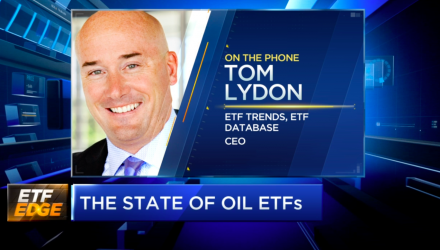There’s been a lot of talk about oil in recent weeks, with plenty of changes happening for better and worse. ETF Trends’ CEO Tom Lydon, along with Todd Rosenbluth of CFRA, and Jason Bloom, Director, Global Macro ETF Strategy, at Invesco, put in the call to “ETF Edge,” hosted by CNBC’s Bob Pisani, to go over the recent developments with the Invesco DB Oil Fund (DBO).
The conversation begins with Bloom, as he is directly linked to the fund, and can explain how DBO works, as well as how it differs from the United States Oil Fund (USO). As he states, both are ETFs holding WTI futures contracts. However, DBO, since its inception, has always used an optimization process in selecting which futures contract to own. Before every futures roll, DBO looks one year out the curve and calculates as to which futures contract offers the best ‘cost of carry.’ In some cases, it’s a positive income.
In terms of how to make money currently, based on this structure, Bloom explains how it depends on what the investors’ expectations are, as well as their time frame. Funds like USO used to give high sensitivity in the short term to daily moves and price curves. If the view is that crude oil will move in one direction or another for the next 8-12 months, DBO allows investors to look at that, and they can see how a futures contract will hold, before making new calculations.
It’s the transparency that ultimately helps, as far as getting an understanding of exposure through DBO. That means investors can do the math in terms of figuring out a level of expectation to anticipate. But does this make DBO predictable on a month-to-month basis?
As Bloom states, “We believe it’s the best balance between predictability, transparency, and having some sort of dynamic optimization. You have transparency, and the DBO’s index is going to hold that, as DBO’s purpose is to track that index. It’s going to hold that contract until right around February 1st. Then, depending on the shape of the curve, it will roll to another futures contract.”
Watch Experts Explain The DBO Advantage:
From Lydon’s perspective when it comes to certain dangers surrounding this, he notes how many investors who thought to buy USO believed they might profit from future oil prices when people begin driving and flying more, again. However, they bought, essentially, inactivity in these areas, while a bunch of tankers sit off the coast. That’s the benefit of DBO, as it lets investors “look under the hood.”
As Lydon continues, “We’re in a situation with DBO where, in buying that March 2021 contract, there is a much better chance than if we do get a recovery in the economy that those who are investing may be able to participate in that rebound. But, if they don’t happen to hit it dead on, they can go forward into other contracts down the road, once we get closer to that March 2021 date.”
Related: Dave Nadig Talks USO Issues and Oil Options On Yahoo Finance
Moving to Rosenbluth, the question becomes whether or not there should be some kind of disclosure from the financial firms or the SEC as far as educating investors on how this market has evolved. He agrees that these kinds of products are making things more difficult for investors, adding how it is harder to understand what they are actually owning.
Currently, USO and DBO have a six basis point difference and looking at the last few years, there’s over 2,000 in basis point performance. So, it’s necessary to understand what’s inside the portfolio, how these are different, and determine if it’s even appropriate for clients.
For more market trends, visit ETF Trends.
